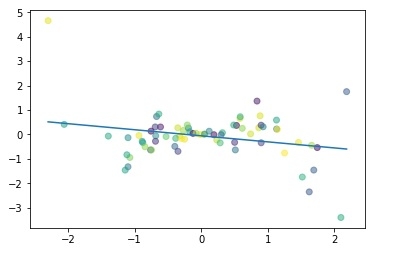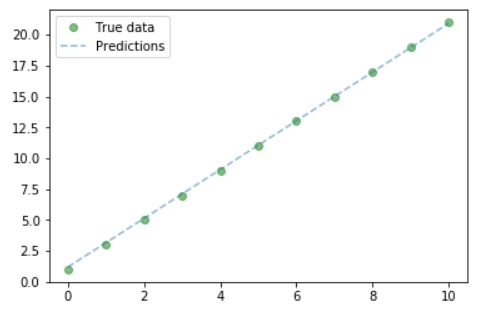使用 PyTorch 進行線性迴歸?
線性迴歸簡介
簡單的線性迴歸基礎
它讓我們理解兩個連續變數之間的關係。
示例 −
x = 自變數
體重
y = 因變數
身高
y = αx + β
讓我們透過一個程式瞭解簡單的線性迴歸 −
#Simple linear regression import numpy as np import matplotlib.pyplot as plt np.random.seed(1) n = 70 x = np.random.randn(n) y = x * np.random.randn(n) colors = np.random.rand(n) plt.plot(np.unique(x), np.poly1d(np.polyfit(x, y, 1))(np.unique(x))) plt.scatter(x, y, c = colors, alpha = 0.5) plt.show()
輸出

線性迴歸的用途
最大程度地減少點和線 (y = αx + β) 之間的距離
調整
係數:α
切點/偏差:β
使用 PyTorch 構建線性迴歸模型
假設我們的係數 (α) 為 2,切點 (β) 為 1,則我們的方程將變為 −
y = 2x +1 # 線性模型
構建資料集
x_values = [i for i in range(11)] x_values
輸出
[0, 1, 2, 3, 4, 5, 6, 7, 8, 9, 10]
# 轉換為 numpy
x_train = np.array(x_values, dtype = np.float32) x_train.shape
輸出
(11,)
#Important: 2D required x_train = x_train.reshape(-1, 1) x_train.shape
輸出
(11, 1)
y_values = [2*i + 1 for i in x_values] y_values
輸出
[1, 3, 5, 7, 9, 11, 13, 15, 17, 19, 21]
#list iteration y_values = [] for i in x_values: result = 2*i +1 y_values.append(result) y_values
輸出
[1, 3, 5, 7, 9, 11, 13, 15, 17, 19, 21]
y_train = np.array(y_values, dtype = np.float32) y_train.shape
輸出
(11,)
#2D required y_train = y_train.reshape(-1, 1) y_train.shape
輸出
(11, 1)
構建模型
#import libraries
import torch
import torch.nn as nn
from torch.autograd import Variable
#Create Model class
class LinearRegModel(nn.Module):
def __init__(self, input_size, output_size):
super(LinearRegModel, self).__init__()
self.linear = nn.Linear(input_dim, output_dim)
def forward(self, x):
out = self.linear(x)
return out
input_dim = 1
output_dim = 1
model = LinearRegModel(input_dim, output_dim)
criterion = nn.MSELoss()
learning_rate = 0.01
optimizer = torch.optim.SGD(model.parameters(), lr = learning_rate)
epochs = 100
for epoch in range(epochs):
epoch += 1
#convert numpy array to torch variable
inputs = Variable(torch.from_numpy(x_train))
labels = Variable(torch.from_numpy(y_train))
#Clear gradients w.r.t parameters
optimizer.zero_grad()
#Forward to get output
outputs = model.forward(inputs)
#Calculate Loss
loss = criterion(outputs, labels)
#Getting gradients w.r.t parameters
loss.backward()
#Updating parameters
optimizer.step()
print('epoch {}, loss {}'.format(epoch, loss.data[0]))輸出
epoch 1, loss 276.7417907714844 epoch 2, loss 22.601360321044922 epoch 3, loss 1.8716105222702026 epoch 4, loss 0.18043726682662964 epoch 5, loss 0.04218350350856781 epoch 6, loss 0.03060017339885235 epoch 7, loss 0.02935197949409485 epoch 8, loss 0.02895027957856655 epoch 9, loss 0.028620922937989235 epoch 10, loss 0.02830091118812561 ...... ...... epoch 94, loss 0.011018744669854641 epoch 95, loss 0.010895680636167526 epoch 96, loss 0.010774039663374424 epoch 97, loss 0.010653747245669365 epoch 98, loss 0.010534750297665596 epoch 99, loss 0.010417098179459572 epoch 100, loss 0.010300817899405956
因此,我們可以看出從第 1 個曆元到第 100 個曆元,損失已大幅減少。
繪製圖形
#Purely inference predicted = model(Variable(torch.from_numpy(x_train))).data.numpy() predicted y_train #Plot Graph #Clear figure plt.clf() #Get predictions predicted = model(Variable(torch.from_numpy(x_train))).data.numpy() #Plot true data plt.plot(x_train, y_train, 'go', label ='True data', alpha = 0.5) #Plot predictions plt.plot(x_train, predicted, '--', label='Predictions', alpha = 0.5) #Legend and Plot plt.legend(loc = 'best') plt.show()
輸出

因此,我們可以從圖形中看出我們的真實值和預測值非常相似。

廣告

 資料結構
資料結構 網路
網路 RDBMS
RDBMS 作業系統
作業系統 Java
Java iOS
iOS HTML
HTML CSS
CSS Android
Android Python
Python C 程式設計
C 程式設計 C++
C++ C#
C# MongoDB
MongoDB MySQL
MySQL Javascript
Javascript PHP
PHP